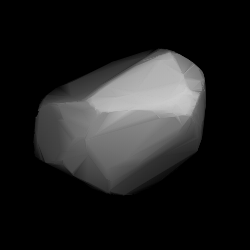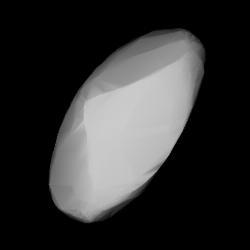Related Research Articles
1509 Esclangona, provisional designation 1938 YG, is a rare-type Hungaria asteroid and binary system from the inner regions of the asteroid belt, approximately 8 kilometers in diameter. It is named after French astronomer Ernest Esclangon.
3043 San Diego, provisional designation 1982 SA, is a stony Hungaria asteroid and slow rotator from the inner regions of the asteroid belt, approximately 4.7 kilometers in diameter.
4674 Pauling, provisional designation 1989 JC, is a spheroidal binary Hungaria asteroid from the innermost regions of the asteroid belt, approximately 4.5 kilometers in diameter. It was discovered by American astronomer Eleanor Helin at the U.S. Palomar Observatory, California, on 2 May 1989, and named after the American chemist and Nobel laureate Linus Pauling.

1088 Mitaka is a bright background asteroid from the inner regions of the asteroid belt. It was discovered on 17 November 1927, by Japanese astronomer Okuro Oikawa at the old Tokyo Astronomical Observatory in Japan. The stony S-type asteroid has a notably short rotation period of 3.0 hours and measures approximately 15 kilometers in diameter. It was named after the Japanese village of Mitaka.
4031 Mueller, provisional designation 1985 CL, is a Hungaria asteroid from the inner regions of the asteroid belt, approximately 4 kilometers in diameter. It was discovered on 12 February 1985, by American astronomer Carolyn Shoemaker at Palomar Observatory, California, and named after astronomer Jean Mueller.

1103 Sequoia is a bright Hungaria asteroid from the innermost region of the asteroid belt, approximately 7 kilometers in diameter. It was discovered on 9 November 1928, by German astronomer Walter Baade at the Bergedorf Observatory in Hamburg, Germany, who named it after the Sequoia National Park located in California.
3225 Hoag, provisional designation 1982 QQ, is a dynamical Hungaria asteroid from the innermost regions of the asteroid belt, approximately 5.5 kilometers in diameter. It was discovered on 20 August 1982, by American astronomer couple Carolyn and Eugene Shoemaker at the Palomar Observatory in California. The stony S/L-type asteroid has a short rotation period of 2.37 hours. It was named for American astronomer Arthur Hoag.

2839 Annette is a bright Flora asteroid from the inner regions of the asteroid belt. It was discovered on 5 October 1929, by American astronomer Clyde Tombaugh at Lowell Observatory during his search for Pluto. The presumed S-type asteroid has a rotation period of 10.5 hours and measures approximately 5 kilometers in diameter. It was named after the discoverer's daughter.
1823 Gliese, provisional designation 1951 RD, is a stony Flora asteroid from the inner regions of the asteroid belt, approximately 8 kilometers in diameter. It was discovered on 4 September 1951, by German astronomer Karl Reinmuth at Heidelberg Observatory in southern Germany. The asteroid was named after German astronomer Wilhelm Gliese.
3353 Jarvis, or by its provisional designation, 1981 YC, is a carbonaceous Hungaria asteroid, slow rotator and suspected tumbler from the inner regions of the asteroid belt, approximately 10 kilometers in diameter.
5899 Jedicke, provisional designation 1986 AH, is a binary Hungaria asteroid approximately 3 kilometers in diameter. It was discovered on 9 January 1986, by American astronomer Carolyn Shoemaker at Palomar Observatory, and named after the members of the Canadian Jedicke family.
5905 Johnson, provisional designation 1989 CJ1, is a Hungaria asteroid and synchronous binary system from the innermost regions of the asteroid belt, approximately 4 kilometers (2.5 miles) in diameter. It was discovered on 11 February 1989, by American astronomer Eleanor Helin at Palomar Observatory in California, United States. Its satellite measures approximately 1.6 km (1 mi) in diameter and orbits its primary every 21.8 hours. It was named after American astronomer and engineer Lindley N. Johnson.
4868 Knushevia, provisional designation 1989 UN2 is a bright Hungaria asteroid and suspected binary system from the innermost regions of the asteroid belt, approximately 2 kilometers in diameter. It was discovered on 27 October 1989, by American astronomer Eleanor Helin at the Palomar Observatory in California, United States. The asteroid was named for the Kyiv University in Ukraine.
3066 McFadden, provisional designation 1984 EO, is a stony background asteroid from the central regions of the asteroid belt, approximately 15 kilometers in diameter. It was discovered on 1 March 1984, by American astronomer Edward Bowell at the Anderson Mesa Station near Tucson, Arizona. It was named for American planetary scientist Lucy-Ann McFadden. The assumed S-type asteroid has a rotation period of 13.8 hours.
1857 Parchomenko, provisional designation 1971 QS1, is a stony asteroid and suspected binary from the inner regions of the asteroid belt, approximately 8 kilometers in diameter.
For other uses, see Steel (disambiguation).

4765 Wasserburg (prov. designation: 1986 JN1) is a bright Hungaria asteroid, suspected binary system and asteroid pair from the innermost regions of the asteroid belt, approximately 3 kilometers (1.9 miles) in diameter. It was discovered on 5 May 1986, by American astronomer Carolyn Shoemaker at Palomar Observatory, and later named after geologist Gerald J. Wasserburg.
4440 Tchantchès, provisional designation 1984 YV, is a rather elongated Hungaria asteroid and a possible binary system from the inner regions of the asteroid belt, approximately 3 kilometers in diameter.
5477 Holmes, provisional designation 1989 UH2, is a Hungaria asteroid and binary system from the innermost regions of the asteroid belt, approximately 3 kilometers (2 miles) in diameter. It was discovered on 27 October 1989, by American astronomer Eleanor Helin at the Palomar Observatory in California. The presumed E-type asteroid is likely spherical in shape and has a short rotation period of 2.99 hours. It was named for American amateur astronomer Robert Holmes. The discovery of its 1-kilometer-sized minor-planet moon was announced in November 2005.
(6382) 1988 EL is a stony Hungaria asteroid from the inner regions of the asteroid belt, approximately 5 kilometers in diameter. It was discovered on 14 March 1988, by American astronomer Jeffrey Alu at the U.S. Palomar Observatory, California.
References
- 1 2 3 4 5 6 7 8 9 "JPL Small-Body Database Browser: 1919 Clemence (1971 SA)" (2016-05-28 last obs.). Jet Propulsion Laboratory . Retrieved 9 June 2017.
- 1 2 3 Schmadel, Lutz D. (2007). "(1919) Clemence". Dictionary of Minor Planet Names – (1919) Clemence. Springer Berlin Heidelberg. p. 154. doi:10.1007/978-3-540-29925-7_1920. ISBN 978-3-540-00238-3.
- 1 2 "1919 Clemence (1971 SA)". Minor Planet Center. Retrieved 19 April 2016.
- 1 2 3 4 5 6 "LCDB Data for (1919) Clemence". Asteroid Lightcurve Database (LCDB). Retrieved 19 April 2016.
- 1 2 3 4 5 6 Mainzer, A.; Grav, T.; Masiero, J.; Hand, E.; Bauer, J.; Tholen, D.; et al. (November 2011). "NEOWISE Studies of Spectrophotometrically Classified Asteroids: Preliminary Results". The Astrophysical Journal. 741 (2): 25. arXiv: 1109.6407 . Bibcode:2011ApJ...741...90M. doi:10.1088/0004-637X/741/2/90 . Retrieved 19 April 2016.
- 1 2 Masiero, Joseph R.; Grav, T.; Mainzer, A. K.; Nugent, C. R.; Bauer, J. M.; Stevenson, R.; et al. (August 2014). "Main-belt Asteroids with WISE/NEOWISE: Near-infrared Albedos". The Astrophysical Journal. 791 (2): 11. arXiv: 1406.6645 . Bibcode:2014ApJ...791..121M. doi:10.1088/0004-637X/791/2/121 . Retrieved 21 March 2017.
- 1 2 Warner, Brian D.; Stephens, Robert, D.; Harris, Alan W.; Pravec, Petr (October 2009). "A Re-examination of the Lightcurves for Seven Hungaria Asteroids". The Minor Planet Bulletin. 36 (4): 176–179. Bibcode:2009MPBu...36..176W. ISSN 1052-8091 . Retrieved 19 April 2016.
{{cite journal}}: CS1 maint: multiple names: authors list (link) - 1 2 Warner, Brian D. (September 2005). "Asteroid lightcurve analysis at the Palmer Divide Observatory - winter 2004-2005". The Minor Planet Bulletin. 32 (3): 54–58. Bibcode:2005MPBu...32...54W. ISSN 1052-8091 . Retrieved 19 April 2016.
- ↑ Pravec, P.; Scheirich, P.; Durech, J.; Pollock, J.; Kusnirák, P.; Hornoch, K.; et al. (May 2014). "The tumbling spin state of (99942) Apophis". Icarus. 233: 48–60. Bibcode:2014Icar..233...48P. doi:10.1016/j.icarus.2014.01.026 . Retrieved 19 April 2016.
- ↑ Schmadel, Lutz D. "Appendix – Publication Dates of the MPCs". Dictionary of Minor Planet Names – Addendum to Fifth Edition (2006–2008). Springer Berlin Heidelberg. p. 221. doi:10.1007/978-3-642-01965-4. ISBN 978-3-642-01964-7.